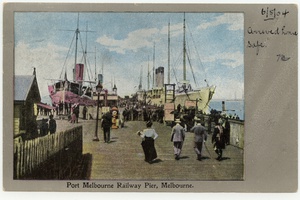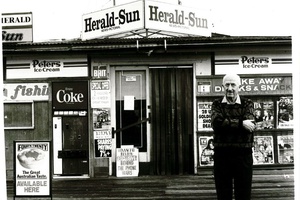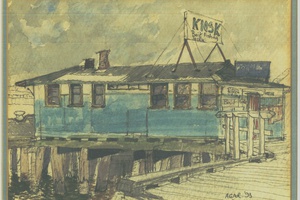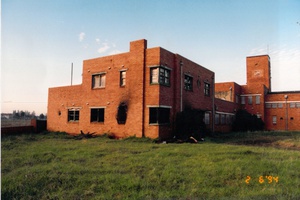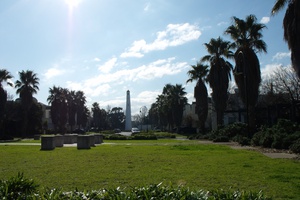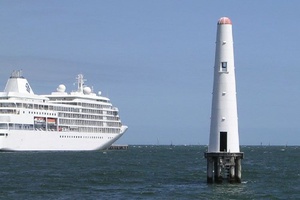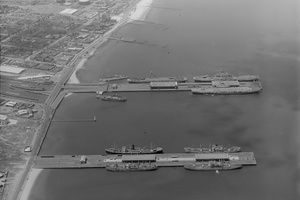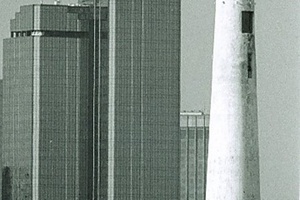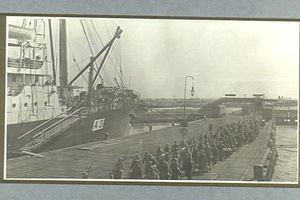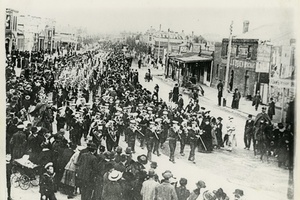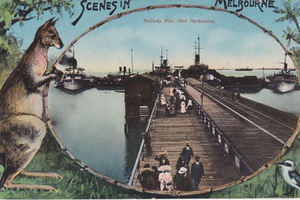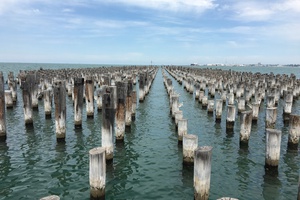-
Railway Pier
A wonderful hand-tinted postcard showing the Port Melbourne Railway Pier, circa 1914.
pastportproject
0 -
Station Pier Kiosk
Photo of the eastern Station Pier Kiosk covered in advertising, before it was moved to the shore end of the …
pastportproject
4 -
Ted Rohan and the Kiosk
Former owner Ted Rohan, outside the western Station Pier Kiosk in 1993. Ted worked there for 48 years, 7 days …
pastportproject
1 -
Kiosk Watercolour
Deni Rohan, daughter of former kiosk owner Ted Rohan, found this watercolour painting of the Station Pier Kiosk, painted in …
pastportproject
1 -
Old Migrant Hostel
Former local resident David Castles recalls the old Fishermans Bend Migrant Hostel. The Fishermans Bend Migrant Hostel was opened in …
pastportproject
0 -
Migrants arriving at the Pier
Deni Rohan discusses the arrival of migrants at Station Pier.
pastportproject
0 -
Hobart Star breaks loose
Michael Hill, former local merchant navy sea man, recalls when the Hobart Star broke its mooring at Station Pier
pastportproject
0 -
Arriving at Station Pier
Local residents Joan and Faris Ahin read a section of their Mother's diary, recalling her arrival into Melbourne. Joan and …
pastportproject
1 -
Mission to Seamen Building
Photo of the former Mission to Seamen building, taken just prior to demolition in 1994. Constructed in 1937 and designed …
pastportproject
0 -
Twin Beacons
The Port Melbourne Leading Lights are twin beacons, built in 1924 to mark the centre of the Port Melbourne Channel …
pastportproject
1 -
The Front Tower
The sea based front tower is a 16-metre tall, timber framed lighthouse tower constructed on wooden piles. Positioned just offshore …
pastportproject
2 -
The Rear Tower
Set 500 metres north of the front tower on land, the rear tower is a 26-metre tall white concrete lighthouse …
pastportproject
0 -
Silent Sentinels
The front tower is located just offshore between Princes Pier and Station Pier, and was historically linked with a footbridge …
pastportproject
0 -
Leading Lights
Leading lights or beacons (also known as range lights in the United States) are used to assist maritime vessels in …
pastportproject
2 -
Guiding Ships
The Port Melbourne Leading Lights were built in 1924, and guided maritime vessels by marking the centre of the Port …
pastportproject
1 -
Heritage Listing
As an iconic bayside landmark, the Leading Lights are a significant part of the Port Melbourne landscape, and have been …
pastportproject
1 -
Beacon Cove placement
As part of the redevelopment of the industrial port area around the Station and Princes Piers during the 1990s, the …
pastportproject
1 -
Princes Pier, Fond Farewells
When thinking about the effects of World War One on Port Melbourne and its people, Port’s piers are a clear …
pastportproject
0 -
Princes Pier, Home Front
Over the course of the war, 1,500 ‘Port boys’ departed for the front. In addition to this depletion of the …
pastportproject
0 -
Railway Pier Postcard
This hand-tinted postcard shows Railway Pier, now called Station Pier, in 1914.This hand-tinted postcard shows Railway Pier, now called Station …
pastportproject
0 -
End of Princes Pier
Wonder what alternatives there could be to the current conservation approach?
SteveC
2 -
The Army and Navy Hotel
This quaint and charming hotel is a reminder that the Sandridge Naval Brigade used to train in Dow Street.
cityofportphillip
1 -
Station Pier
The pier, originaThe pier, originally built in 1854 as Railway Pier, was the ‘passenger gateway’ to Melbourne and the arrival …
cityofportphillip
0 -
Seamen's Institute
The building on the corner of Nott and Beach Streets housed the Seamen’s Institute , once a refuge for the …
cityofportphillip
0 -
Pier Hotel
The building on the corner of Bay and Beach Streets is the Pier Hotel on the site of the timber …
cityofportphillip
0
